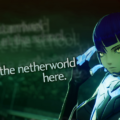Cognition Dissemination: Geoff’s Favorite Games of 2021

I can’t remember the last time I played and finished several games released within a certain year by the end of that year. I’ve been shaving my backlog down for so long that I’ve forgotten what it feels like to purchase and play a bunch of new games right behind each other. Case in point: I only finished two 2021 games in 2021, making this the worst year yet for me. It would be impractical to provide a list of my favorite games. But since fellow writer Drew Young already provided an alternative “Best of 2021” list and we’ve run through our annual Naughty and Nice series, I’m using this opportunity to discuss the two games I played and liked. It’s the least I can do considering I’m not writing as many reviews anymore.
Shin Megami Tensei V (Nintendo Switch)

I was perhaps a little too excited for Shin Megami Tensei V prior to its release, but for good reason. Every installment in the series I’ve played since the PlayStation 2 era (when they started getting released outside Japan) has ranged from great to excellent, and previews released for this game since 2017 implied how this one would follow the trend. Just as Shin Megami Tensei IV (and eventually its direct successor) was the catalyst for me getting a 3DS before it released in 2013, SMTV was the game that finally nudged me into getting a Nintendo Switch — with the OLED edition arriving just in time. The game was fortunately was as great as I expected, because man would I have been viciously owned if I found it disappointing.
Every SMT title distinguishes itself by its in-game apocalyptic events being achieved in different ways, and SMTV has another unique one. Sure, it largely takes place in a post-apocalyptic version of Tokyo, but the main characters are transported to the location, known as Da’at, after demons start appearing in what they see as the real world.
The story comes off as an excuse to have a different iteration of a dilapidated and destroyed Tokyo compared to what previous games provided, and the characters don’t receive the best development. But it does a fine-enough job of moving the game along. There are interestingly more memorable parts in the side quests compared to the main story, the opposite of what anyone might have expected. SMT games are all about the demons, after all.
The versions of Tokyo in previous SMT games have allowed for players to explore the various districts and wards of the city overrun with cynical humans and demons, but I appreciated how SMTV takes this to the next level compared to the open cities from the SMTIV games.
This installment does away with the need for the player to wander from one section of each city to another from the overworld map in favor of having four large zones open for exploration. It takes cues from Xenoblade Chronicles 1 and especially 2 by requiring the player to explore parts of each area to search for ways to progress and find secrets. I enjoyed the exploration to the point that I was sad after I wrapped up the final area. The combination of the approach to exploration and the superlative graphics and art style for a Switch game sometimes results in the system being pushed a little too hard, which results in the framerate suffering, but I’m still glad they went with it.
This presentation switch (ha) wasn’t to everyone’s tastes, especially since this focus led to the intricate dungeons from previous installments taking an even larger backseat than they did in the SMTIV games. But I’m hoping they stick with it for future installments while also having more dungeons — assuming that’s not too much to ask for.

SMT games focus heavily on battles, the features for which have received few changes in SMTV compared to its predecessors. The Press-Turn system is retained for core battles, which focuses on exploiting weakness for extra turns while robbing enemies of their turns, while demon recruitment and fusion are still necessary to survive. Even if they’re still using the same battle system established in Shin Megami Tensei III: Nocturne in 2003, it’s tough to get tired of it when no other games have systems like it. While the main Nahobino protagonist (the result of a forbidden fusion between a human and otherworldly being) has a nice array of unique attacks, he needs good demons for assistance. They never stop being interesting when the game’s difficulty rarely lets up, a way to inform the player of how buffs and debuffs are more important compared to other Japanese RPGs.
There was no way I could end this section without discussing the sublime soundtrack. Lead composer Ryota Kozuka’s style fits the SMT series better than Shoji Meguro’s, as he and Toshiki Konishi pumped out a wide array of battle themes for this game in addition to those suitable for other environments and story developments. It doesn’t quite reach the heights of the SMTIV soundtrack, perhaps due to a change in style after Japan apparently didn’t like that game’s soundtrack all that much, but it’s still great.
I admittedly found myself wishing there were more dungeons by the game’s end, but this was not enough to stop SMTV from being one of the best JRPGs I’ve played in the last few years. More than anything, I’m glad the financial investment ended up being worth it, with the 80-odd hours required for one playthrough. I’ll make sure to replay it to obtain the other three endings sometime in 2022, with a different Nahobino build and perhaps the DLC.
Scarlet Nexus (PlayStation 4, but also on PlayStation 5, Xbox Series, Xbox One, and PC)

Scarlet Nexus was another one of Bandai Namco’s experiments, similar in, well, vein to Souls-alike Code Vein. A game development team with leaders previously responsible for helming several Tales of games tried their hand at a new IP. It always looked interesting enough from the trailers, though previews didn’t provide a good opportunity to understand the game’s flow. They also didn’t focus on gameplay features that would have been referred to as “boring” while being demonstrated in official promotional videos. The game is a bit rough around some of its edges, but all of the features come together for a satisfying experience.
The story is fine enough, featuring main characters Yuito Sumeragi and Kasane Randall who fight alongside their accomplices to protect the futuristic New Himuka against invading beings known as Others. The combat is where the game shines brightest. The player can only control the protagonists while AI handles the party members, but the main characters have access to so many abilities (some of which can be borrowed temporarily from accomplices) to ensure that they have a worthwhile variety of tools at their disposal. The game also includes downtime moments between missions where the main characters can bond with teammates after working with them in missions and giving them gifts, similar to the Persona series’ Social Links. Here, though, it’s easily possible to unlock all of them on both routes before the game ends without stressing about them.
The game does feel a bit padded out between the two routes. It’s nice that the characters retain their levels between the two playthroughs, but the first halves of both are better thanks both Yuito and Kasane experiencing different story events. The second halves of both their campaigns are nearly identical, which means the levels and story developments are largely similar. I also wished the game was a bit less linear and more open, though it’s not like the player is forced to walk in a straight line through its levels. Budget constraints were the likely reason for this, in addition to the story presentation largely relying on still character models rather than fully-animated cutscenes.
Scarlet Neuxs’ positives well outweigh the negatives, and anyone who likes action RPGs and was curious about it should give it a shot for the prices it goes for these days. Bandai Namco didn’t put out any kind of press release celebrating its sales like they did for Tales of Arise shortly after its release, so I’ll assume it sold below expectations. That’s unfortunate considering how a small number of its plot contrivances weren’t wrapped up by the game’s end. At least the stories for the main characters wrap up satisfyingly.
If there’s one New Year’s Resolution I should make that I’m sure to fulfill, it’s that I promise to play and finish more games released in 2022 within that year. Given the amount of them I went through in 2021, that should be easy to reach. But I know better than to guarantee it. Maybe I should have planned another post where I discussed games I enjoyed that didn’t release this year, like 13 Sentinels: Aegis Rim and Hades. But again, there’s always next year.






Great resolution for 2022! Nice review too … haven’t pulled trigger on SMT 5 yet but you have sent me pining for it. Love the comparison to xenoblade. Playing xenoblade 2 right now (yes very much not a new release ) but still a must.
Hey, I’m glad I might have sold someone on it! I’ve only played a little of Xenoblade Chronicles 2, but I have the first game sitting here, and I might as well get through that one first. I’m hoping to play through both next year.